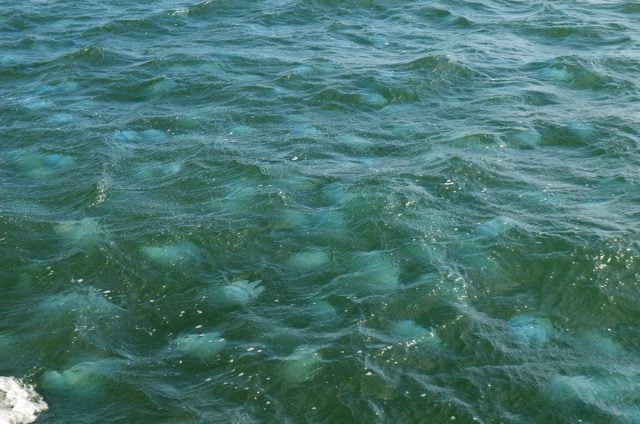
By Mary Gardner
Chugging up the Pumicestone Passage in the tour boat, all of us from the conference watched the bloom of jellyfish go by.
The pale blue animals crowded the 35-kilometre waterway between the Sunshine Coast and Bribie Island. Also blooming was Lyngbya, large clusters of toxic blue-green algae.
All these creatures take advantage of the mix of warm water, sunshine, sediments from deforested lands and runoff from urban and canal estates.
They also thrive because a critical marine animal, once found in wild millions, is now missing. Oysters.
The futures of wild oysters brings us researchers, activists and community leaders together. We’re dreaming to once more oysters see living free for their full lifespan of some forty odd years.
We want to see them back in action. They, along with other bivalves such as mussels and clams, are phenomenal aquatic housekeepers. That’s what the coastal marine world needs now more than ever.
Each adult oyster clears particles from a total of 7.5 litres in an hour. That’s about 189 litres in a day. Content on less than half a hectare, 750,000 animals living en masse can filter 57-157 million litres of sea water each and every day.
Biologists calculated such a community extended over 166,000 square kilometres in the Chesapeake Bay would have filtered all the water once every three days.
In the course of filtering, each oyster sorts through every particle in the water. What they don’t like, they coat with mucus and spit out. This falls to the seabed. They eat the rest: algae, larvae, eggs and hatchlings of fish and jellyfish.
Over the year, oysters have regular group sex, releasing eggs and sperm during several spawning events. Over their lifetimes, they may change sex too. The young drift off and grow a little. Then, as tiny spat, they deliberately settle on shells in the oyster community or another favourite hard surface close by.
For thousands of years, the Pumicestone Passage held hectares of ‘bank’ oysters across the shore and ‘dredge’ oysters in the subtidal depths. Their daily routines cleared the waters. Their existence provided habitat and food for fish, birds, sharks and rays and many other kinds of marine life. Some, like darts, known as ‘oystercrushers’ munched the adults. Others, like small sharks, cruised through the clouds of spawn gulping the caviar.
What became of these reefs of oysters, this living armoured ‘skin’ of the coastal sea? Political ecologists say that in Queensland, in New South Wales and all the rest of not only Australia but the whole world, a crazy idea infected humanity. Oysters were considered a commodity. Intensive commercial exploitation led to the collapse of oyster reefs and their communities.
Live oysters were sold by the sack or barrel, shipped all around the world. Shell was pulled up in great chunks to be burned to create lime for construction and agriculture. Without a trace of irony, In Australia this process was called skinning.
Over 96 per cent of the reefs, with their habitat, food and water filtering services, all disappeared in this economic free-for-all. Remember Chesapeake Bay? By the end of the 20th century, the losses of oysters were so great that filtering the entire bay once over took almost eleven months.

But for thousands of years before, people in many cultures held fast to another idea. Among the Joondoobarrie, as with the Bundjalung and other groups, the women and children returned shell to the edges of reefs for the spat to settle. Over time, this task and other related work enhanced and extended oyster reefs. Although the people took and ate plenty, they also put back for the future.
The oyster commons were also important socially. Families had a universal basic income in the form of daily access to high quality protein and vitamins. Always handy for a feed, delicious raw but try covering some with a woven mat which is then set on fire. Oysters on the half-shell, opening exactly when they are perfect to eat.
Some early settlers in Australia appreciated the oyster commons and set aside small public oyster reserves for such outdoor meals. Brunswick Heads had a reserve at least into the 1930s and Ballina up to the 1960s. They’re gone without fanfare. But in the USA, oyster wars were fought when such oyster commons were privatised.
Us shellfish people, we see two great steps ahead. The first is to give back. Oysters were once free living wild animals and can be again. Communities in Victoria and South Australia, in New Zealand, in New York City and Chesapeake Bay, are putting back oysters. Old shells set in gabion baskets, embedded in concrete forms, into coir sacks or thrown down as a loose carpet in the subtidal are being returned to the sea. Sometimes shells are seeded with spat from an oyster farm or hatchery.
These projects create important jobs in local communities worldwide. Shocked by superstorms, New Yorkers invest in ‘oyster-techture’: reefs that double as living shoreline protection. South Australia is putting over $3 million dollars into reefs as repair of their natural coastal infrastructure. Bribie Islanders are experimenting with oyster gardens growing off the pontoons in canals.
The second step is open-ended. The return of oysters will first benefit seawater and marine life. Then one day, when the bivalve housekeepers get on top of their work, people will have access to good local wild food.
Anticipating that time, we need to wise-up our citizens of the future. Humanity just might get a second chance to care for and share in a sustainable coastal commons.




Great story Mary! but you forgot to mention the pirates:)